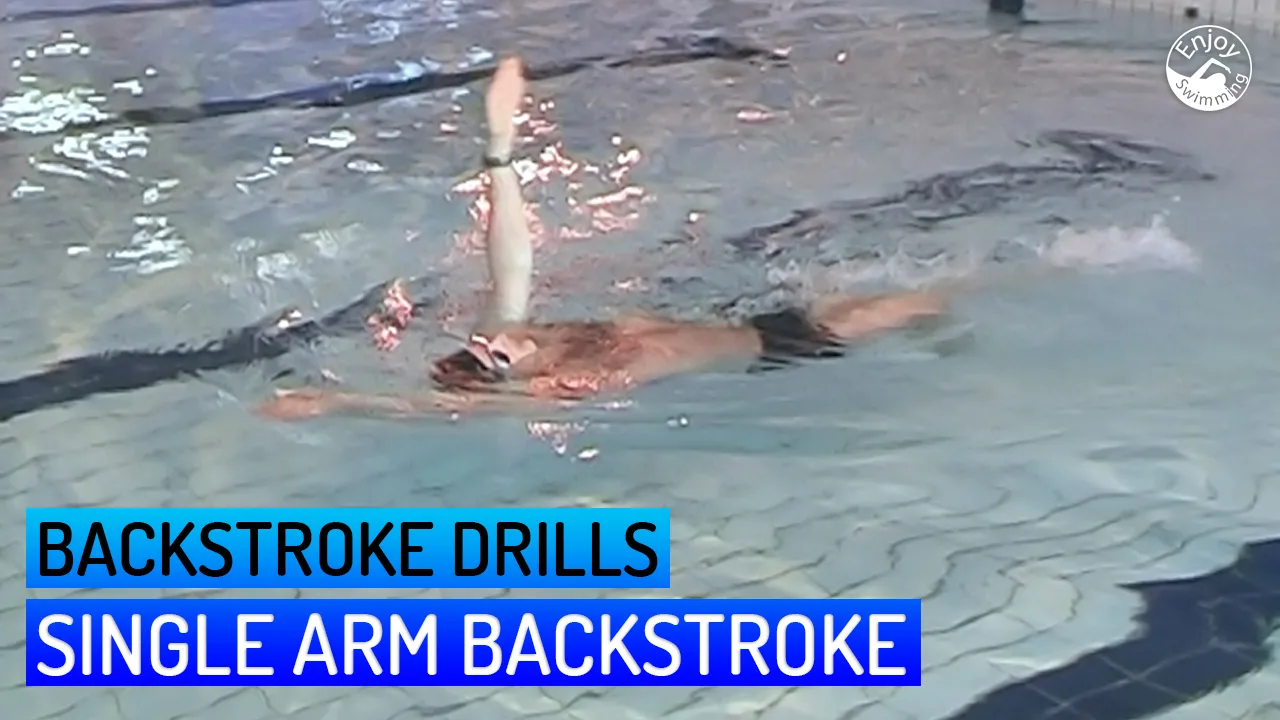In the following drills to learn to swim backstroke, you’ll practice the arm recovery above water in addition to the underwater arm sweep you learned previously.
However, to keep things simple, you’ll practice the arm stroke movements one arm at a time.

This allows you to sidestep coordination issues that can occur when you move both arms simultaneously. This also allows you to better focus on the arm movements.
Single-Arm Backstroke, Idle Arm Resting Overhead
The first swimming drill lets you execute the arm stroke movements with one arm while the other one is extended overhead:
This drill starts exactly like the previous backstroke drills:
- Go to the shallow area of the pool.
- Lean on your back.
- Push off the ground.
- Start to flutter kick.
- Keep both arms at your sides.
- Get into a horizontal position on your back.
- Your head is aligned with your spine, and you look straight up towards the ceiling.
- Once you feel balanced in that position, extend one of your arms forward under water. You’ll keep that arm in this position for the rest of the length.
Start the recovery above water with the other arm, using a correct technique:
- Your arm starts extended along your side, with the palm turned inwards.
- Your arm exits the water thumb first and elevates in a circular movement until it points straight up, at a 90° angle with the water surface.
- Your arm continues its half-circular movement forward, and the palm starts to rotate outwards.
- Finally, your arm enters the water in front of you with the pinky finger first.
- Your other arm doesn’t move and is extended forward all the time.
Once you’ve finished the arm recovery, your active arm starts its propulsive underwater phase. You practiced this in Under Water Arm Sweeps:
- Your arm is extended forward.
- Angle your wrist.
- Turn your palm so that it is facing backward.
- Bend your elbow and start to push back against the water with your palm and forearm.
- Sweep backward with your arm until your hand arrives at the level of your hips, and your arm is straight again.
- At that moment, exit the water thumb first with the active arm and start the recovery.
You should change the active arm with each length. Please practice this swimming drill until you can keep your balance from head to toes all the time, even during the arm recovery above water.
Single-Arm Backstroke, Idle Arm Resting at the Side
The next drill to learn to swim backstroke is similar to the previous one, but instead of keeping the idle arm extended forward, you’ll keep it at your side.
This makes this swimming drill more difficult than the previous one because the idle arm isn’t there to provide buoyancy to your head when the other arm ends its recovery forward.
Here’s a video that demonstrates the drill:
Additional Tips
Don’t forget to roll from side to side. The shoulder of the active arm rises above water during the recovery and drops down during the underwater arm sweep.
Learning Path for the Backstroke
Below is an overview of our series of articles on learning the backstroke. Each article in this series contains one or more drills that have to be mastered. The current article is highlighted:
Once you have gone through all the steps of this learning path, you should be able to swim backstroke without any problems.
Good luck!
